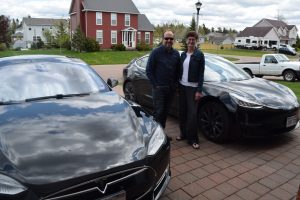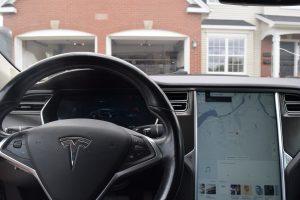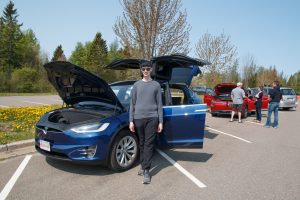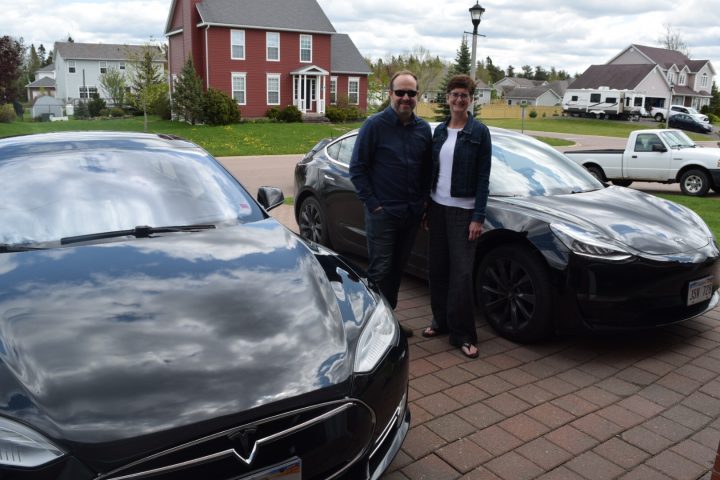The small but growing New Brunswick Tesla community is a testament EVs are here to stay

When Michael O’Pray drives his Tesla Model 3 in New Brunswick, it feels like he’s on display.
The Riverview resident recalls driving with his boss before strangers signaled Michael to roll down his window. They wanted to know the make and model.
“Does that happen a lot?” his boss asked.
“Yes,” Michael replied. “Every day.”
After making it to space, Elon Musk’s cars are finally breaking through in an even more remote location, New Brunswick. The small but growing Atlantic Canada Tesla community is a testament to the power of electric vehicles and how they’re no longer mere sci-fi fantasy.
The salesman and his wife, Adrienne, own two Teslas, a Model 3 and a rear-wheel-drive Model S they bought used.
Their two cars sit in the driveway and with a touch of a button, the Model 3 begins to slowly, silently creep forward without a driver.
But it’s not the luxury status or the fancy features that attracted the couple. They allow family, friends and even strangers drive their cars to show them the technology isn’t beyond the average person’s reach.
“With these cars you just have such little maintenance that the cost makes sense,” said Adrienne, president and CEO of the non-profit New Brunswick Business Council.
Lack of salespeople, O’Pray
According to a recent CBC New Brunswick article, an estimated 200 electric vehicles will be seen cruising the streets and highways of the province this year.
It’s difficult to determine how many of those are Teslas, but some drivers, part of a Maritime-Telsa Facebook page, estimate it’s between 25 and 60 in all three Maritime provinces. A representative for Tesla did respond to the CCNB’s email, only to say he didn’t have more accurate numbers.
NB Power invested heavily in developing and expanding its network of charging stations, a decision for which it drew criticism. New Brunswick has more than 200 stations, both publicly and privately owned.
It also has more Level 3 or “fast chargers” per capita than any other province, Michael said.
“If you don’t put this infrastructure in and get behind it, then nothing’s going to change,” he said.

But while the critique of the NB Power has played out in the media, Michael said the real problem for electric vehicles is a lack of salespeople to push the product.
Teslas inside the province are imported, mostly from Quebec or Ontario. But when the couple first purchased the Model S, an acquaintance who once worked for Tesla gave some advice.
“He said, ‘The first thing that you are worried about is range anxiety. And it’s going to be the first thing you forget about,’” Michael said. ‘He said it will take five days and he was right.”
Part of a community
At the Conservation Council’s 2019 Eco Buildings Tour, Dusty Phillips, who drives a 2017 Tesla Model X, stands next to his car in Hampton.
The hood was left open so participants could see there’s no engine hidden underneath, just storage space.
Dusty said he doesn’t have problems driving around the province.
He was first attracted to the technology in the car rather than the smaller carbon pollution footprint.
“I’ve become more interested in the climate side of things since I got the car,” he said. “A lot more interested.”

The self-described ‘technologist’ said when you drive a Tesla, it’s like being part of a community. He can now recognize all the electric cars he sees around the province.
And it goes beyond just waving at fellow EV drivers.
“When the flooding was going on, there were post across Atlantic Canada saying, ‘if you need a place to charge, my charger is available,’” he said.
$8.50 to charge overnight
Back in Riverview, the couple let their Bernese Mountain Dog play in the front yard. Her name is Tesla.
“There’s a real mindset that these cars are more expensive,” Adrienne said. “You have to look at the total cost of ownership of the vehicle.”
The couple is reluctant to say, however, how much they’ve paid for their two vehicles.
Adrienne believes what’s needed are additional tax incentives or tax credits, allowing people to overcome the initial barrier of buying an electric vehicle.
She said it costs $8.50 to charge their car overnight.
And so far, they’ve put 150,000 kilometres on the Model S and haven’t needed much maintenance. Tesla sends the newest software updates directly to the car.

“If you put 150,000 on a gas vehicle, you’re doing a lot of maintenance in filters, breaks, oil changes. All of those things,” she said.
“The new Model 3, with the tax incentives with the federal government, in New Brunswick can be had for $50,000,” Michael said. “That car will go 375 kilometres on a charge.”
And while it’s often electric vehicles’ range that is criticized, the two travel for work.
“Most people won’t be driving 500 kilometres before they stop,” Michael said.
Built to last
Like Dusty, Michael said owning a Tesla is like being in a community and the used-Tesla market is the fun secret few people buy into.
But when the couple bought their Model S, it still had six years warranty on it – proving to them Musk’s cars, like Ford’s, were built to last.
“That’s incredible,” Michael said. “To buy a car and know they’ll keep improving it while you have it.”
Recommended links
- Conservation Council welcomes $1B investment in energy efficiency, long-awaited incentives for electric vehicles, and support for coal workers in N.B.
- ‘Now I’m making plans’: 2019 Eco Buildings Tour inspires change and hope
- Happy problem: Drive Electric NB’s rebate program was so popular it had to end early
- Electric vehicle charging stations coming to some provincial parks
- The Benefits of Electric Cars
- eCharge Network a key step: Corbett on transition to electric vehicles
- The revolution will be motorized with electricity: The shift toward electric cars is happening in Canada now

